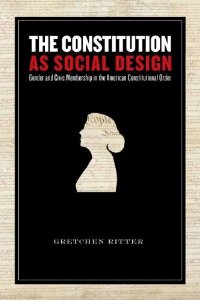Poison Cup – M. Ward
I just finished Gretchen Ritter’s The Constitution As Social Design, which attempts to connect our Constitutional processes to our conceptions of civic membership, often in very interesting ways. I can’t 100% recommend the book, since I think it often struggles to successfully walk the line between historical detail and political theory. She ends by calling for a sort of publicly-minded civic membership that feels unduly optimistic and thinly developed. For a book that has exhaustively detailed the ways that theoretical gains have been twisted by their social contexts, the affirmation of this Arendtian public feels much too easy.
That said, the historical details are wonderful in their own right. Of those, I found her discussion of the Civil Rights Act to be particularly compelling. I knew vaguely that the inclusion of gender in Title VII – the most important part of the CRA, which protects against employment discrimination – reflected some of the larger tensions between race and gender at the time. However, I was not aware of just how interesting the story actually is.
The amendment to include sex provisions was introduced by Howard Smith, a Democrat from Virginia. Smith was a strong segregationist who had spent most of late-1963 attempting to bottle the CRA up in Committee. With the Kennedy assassination and LBJ’s effort to make this bill the key part of honoring JFK’s legacy, Smith couldn’t hold back the tide anymore. However, he didn’t give up the fight. Thinking that he could drive a wedge into the pro-CRA coalition, he offered the one-word amendment to add ‘sex’ as a covered category under Title VII. The idea was that the more radical supporters of the bill would also want this sex amendment, but many Northern moderates would see it as a direct threat. In particular, the notion of encouraging female employment seemed to endanger unions, who were the key base for many Northern Democrats. It was therefore meant as a kind of poison pill.
Of course, the tide of support for the bill ending up overwhelming that effect. And sex-protections ended up enshrined in law, much to the surprise of virtually everyone.
However, this story is incomplete. While Smith certainly was attempting to derail the bill, his segregationist goals do not seem to be his only motives. Surprisingly, he was actually a strong supporter of women’s rights. The amendment, therefore, seems to have been an attempt to kill the bill AND a way to improve the bill if it did pass.
In the current political climate, an alliance between intense racism and feminism seems almost impossible to imagine, but it seems to have been sustainable in the early 60s. The CRA, sans amendment, would have given black men a serious workplace advantage over white women. Given that, you can see how even those without particular feminist impulses might still support the amendment as a limited backstop for white supremacy.

